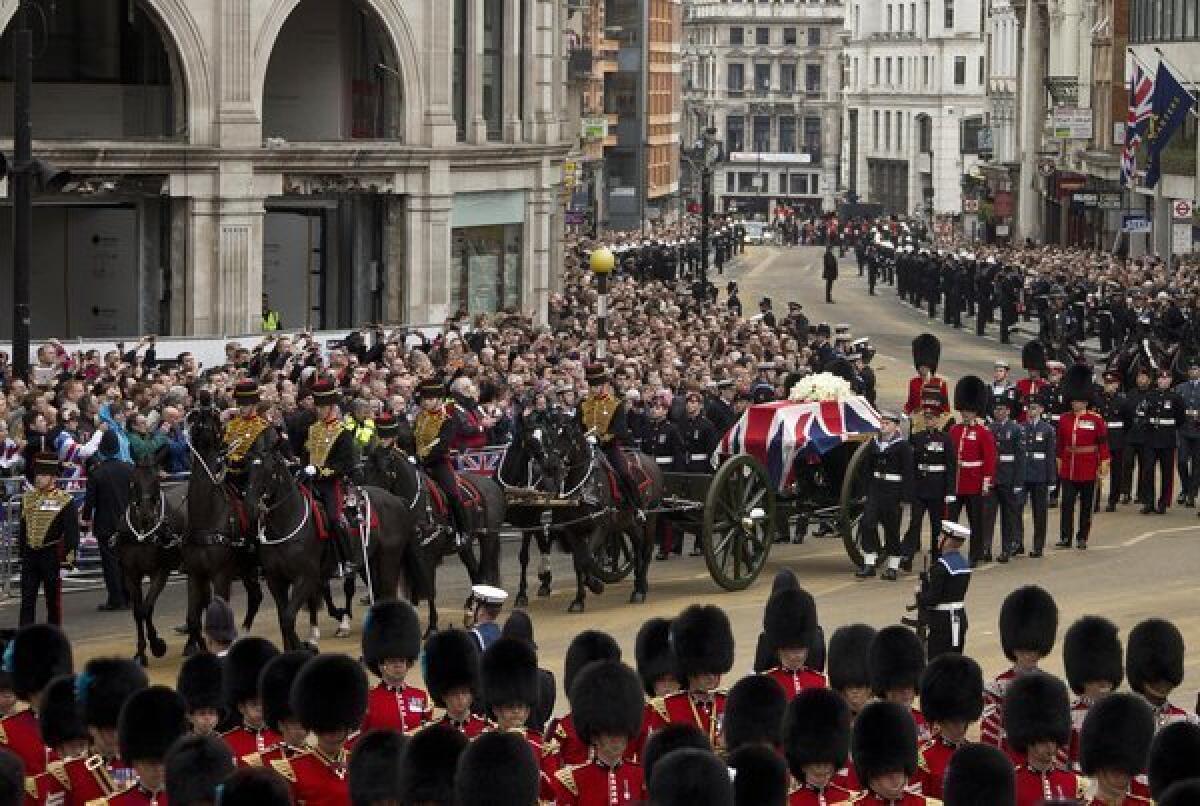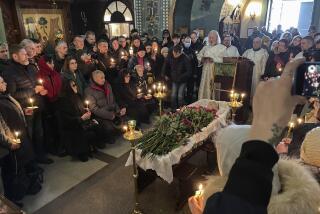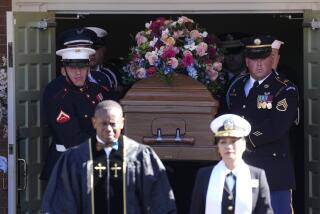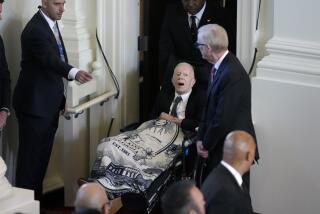To cheers and jeers, Margaret Thatcher is laid to rest

LONDON -- A gun boomed once a minute, like one of her thunderous speeches in Parliament. Gray skies slowly turned blue, the color of her Conservative Party. And even Big Ben fell quiet, in tribute to a woman who loved nothing more than silencing her foes.
With stately solemnity and military honors, Britain bade farewell Wednesday to Margaret Thatcher, its first and only female prime minister, who transformed this country for good or ill in nearly a dozen years at the top and who captured the imaginations of people around the world.
More than 2,000 mourners filled St. Paulâs Cathedral for the funeral, changing its splendid, light-filled interior into a sea of black. Among them was the somber figure of Queen Elizabeth II, attending the official sendoff of a former prime minister for the first time since Winston Churchillâs rites in 1965.
Thousands more Britons lined the streets to watch Thatcherâs coffin go by, tracing a route she knew well, from the Houses of Parliament, past the government power centers in Whitehall -- including her longtime residence at 10 Downing St. -- and up the Strand to the cathedral.
She knew well too the divisive effect she had on her fellow Brits and would not have been surprised to see the handful of detractors and protesters sprinkled among the throng of admirers. Nearly a quarter-century since she fell from power in 1990, one of modern Britainâs most passionate politicians continues to inspire an equal passion in many of her compatriots, both positive and negative, over the free-market revolution she unleashed and the sometimes unpredictable consequences that ensued.
Inside St. Paulâs, such questions were gently laid aside in favor of a simple religious service reflecting Thatcherâs spare, Methodist upbringing as a grocerâs daughter before she became Britainâs longest-serving prime minister since 1827.
âThere is an important place for debating policies and legacy, for assessing the impact of political decisions on the everyday lives of individuals and communities .... Here and today is neither the time nor the place,â Richard Chartres, the Church of Englandâs bishop of London, said in a short homily. âThis is a place for ordinary human compassion of the kind that is reconciling.â
Before him lay the coffin, draped in the Union Jack and graced with a spray of white roses. On it rested a card bearing the simple message: âBeloved mother, always in our hearts.â
Thatcher died April 8 at age 87 after years of failing physical and mental health. Officially, she was known as Baroness Thatcher of Kesteven following her retirement from politics, but more famous was the âIron Ladyâ moniker that she wore, imperiously, like a badge of honor.
Despite the nonpartisan ceremony, the guests inside St. Paulâs formed a veritable Whoâs Who of conservatives from both sides of the Atlantic: former Vice President Dick Cheney; Henry Kissinger, George Shultz and James Baker -- all secretaries of State under Republican presidents; and Canadian Prime Minister Stephen Harper.
Shultz and Baker were the official U.S. representatives. No one from the Obama administration was present, which occasioned a bit of sniping in the British media.
Others at the funeral included Thatcherâs son and daughter, Mark and Carol; her four successors as premier; white-haired members of her Cabinets; Israeli Prime Minister Benjamin Netanyahu; former South African President F.W. de Klerk; and well-known figures such as actress Joan Collins, singer Shirley Bassey and composer Andrew Lloyd Webber.
At Thatcherâs own request, there were no eulogies -- only hymns she loved, Bible readings by her granddaughter and Prime Minister David Cameron, and the address by Chartres, who drew laughter with his recollection of being grabbed by the wrist by Thatcher at a party and told in no uncertain terms to avoid eating the duck pate because it was âvery fattening.â
In contrast to the almost austere service, outside the cathedral Thatcher was treated to the colorful pomp and ritual at which this country excels, though not everyone was pleased by the display or the estimated $15 million it will cost taxpayers.
With a military precision and punctuality that Thatcher would have heartily approved of, her coffin was taken out at exactly 10 a.m. from the Palace of Westminster -- home to Parliament, the scene of some of her greatest triumphs -- where it had lain overnight. In a rare move, Big Ben was stopped from tolling.
Spectators several rows deep crowded the sidewalks to see the cortege draw past and pay their respects. Some burst into applause. Others threw flowers.
âShe was terrific,â said Sophie Kefi, a doctor. âIâm only 31, and she was the first prime minister I remember .... She changed this country, made it stronger. She wasnât afraid to stand up for her principles.â
But a handful of protesters were also in evidence, turning their backs on the procession, booing and toting signs decrying the costs of the funeral and of Thatcherâs economic reforms, which critics say created an unequal society that exalted individual greed.
âShe was the biggest thief,â said John Youll, 46. âI lost my job because of her, and Iâve been on the streets ever since. I used to drive the milk delivery trucks in Newcastle ... when she cut the school milk service. Then she shut the coal mines and left people in the northeast with no work.â
About 4,000 police officers were deployed around London to keep the peace, but no untoward incidents were reported. Anti-Thatcher gatherings and rallies were reported in north England, Scotland and Northern Ireland.
Her coffin was borne through central London first in a hearse and then atop a horse-drawn gun carriage, flanked by members of the armed forces. More service personnel lined the route of the procession, bowing their heads as the cortege went by in recognition of the woman who led Britain to victory in the Falklands War against Argentina in 1982.
A gun on the wharf at the Tower of London fired in salute once a minute during the procession.
It was a state funeral in all but name, with the same level of pageantry accorded to the late Diana, Princess of Wales, in 1997 and the queenâs mother in 2002.
Critics have questioned the decision to mount such a ceremony in honor of a leader as polarizing as Thatcher. But Cameron said it was justified for one of the towering figures of 20th century British politics.
âEven those who opposed her policies were perfectly capable of saying this was a remarkable woman, a remarkable woman who impacted our history, so therefore itâs right to mark her passing in this way,â Cameron told the British Broadcasting Corp.
At the cathedral, an honor guard in red tunics and large black-furred hats greeted the arrival of the coffin on the dot of 11 a.m. It was carried out by pallbearers an hour later to the pealing of bells.
âAfter the storm of a life lived in the heat of political controversy, there is a great calm,â Chartres said. âThe storm of conflicting opinions centers on the Mrs. Thatcher who became a symbolic figure, even an â-ism.â
âToday, the remains of the real Margaret Hilda Thatcher are here at her funeral service. Lying here, she is one of us, subject to the common destiny of all human beings.â
A private cremation was held in the afternoon.
ALSO:
Thatcher critics counter official funeral with parties
Thatcher funeral: Scenes of solemnity, protest [Video]
Former British Prime Minister Margaret Thatcher dies at 87
Janet Stobart of the Timesâ London bureau contributed to this report.
More to Read
Sign up for Essential California
The most important California stories and recommendations in your inbox every morning.
You may occasionally receive promotional content from the Los Angeles Times.











